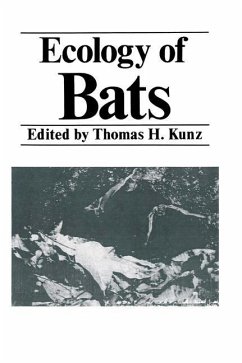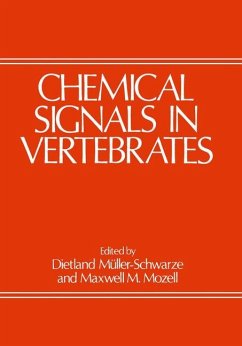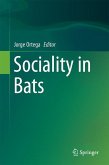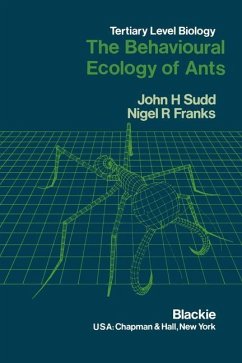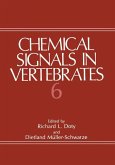Ecology of Bats
Herausgegeben:Kunz, T. H.
Ecology of Bats
Herausgegeben:Kunz, T. H.
- Broschiertes Buch
- Merkliste
- Auf die Merkliste
- Bewerten Bewerten
- Teilen
- Produkt teilen
- Produkterinnerung
- Produkterinnerung
Among living vertebrates bats and birds are unique in their ability to fly, and it is this common feature that sets them apart ecologically from other groups. Bats are in some ways the noctumal equivalents of birds, having evolved and radiated into a diversity of forms to fill many of the same niches. The evolution of flight and echolocation in bats was undoubtedly a prime mover in the diversification of feeding and roosting habits, reproductive strategies, and social behaviors. Bats have successfully colonized almost every continential region on earth (except Antarctica), as weIl as many…mehr
Andere Kunden interessierten sich auch für
![Chemical Signals in Vertebrates Chemical Signals in Vertebrates]() Chemical Signals in Vertebrates79,99 €
Chemical Signals in Vertebrates79,99 €![All Apes Great and Small All Apes Great and Small]() All Apes Great and Small110,99 €
All Apes Great and Small110,99 €![Chromatography and Isolation of Insect Hormones and Pheromones Chromatography and Isolation of Insect Hormones and Pheromones]() Chromatography and Isolation of Insect Hormones and Pheromones77,99 €
Chromatography and Isolation of Insect Hormones and Pheromones77,99 €![Sociality in Bats Sociality in Bats]() Sociality in Bats161,99 €
Sociality in Bats161,99 €![Behavior of Marine Animals Behavior of Marine Animals]() Howard E. WinnBehavior of Marine Animals77,99 €
Howard E. WinnBehavior of Marine Animals77,99 €![The Behavioural Ecology of Ants The Behavioural Ecology of Ants]() J. H. SuddThe Behavioural Ecology of Ants39,99 €
J. H. SuddThe Behavioural Ecology of Ants39,99 €![Chemical Signals in Vertebrates 6 Chemical Signals in Vertebrates 6]() R.L. Doty / Dietland Mller-Schwarze (eds.)Chemical Signals in Vertebrates 6156,99 €
R.L. Doty / Dietland Mller-Schwarze (eds.)Chemical Signals in Vertebrates 6156,99 €-
-
-
Among living vertebrates bats and birds are unique in their ability to fly, and it is this common feature that sets them apart ecologically from other groups. Bats are in some ways the noctumal equivalents of birds, having evolved and radiated into a diversity of forms to fill many of the same niches. The evolution of flight and echolocation in bats was undoubtedly a prime mover in the diversification of feeding and roosting habits, reproductive strategies, and social behaviors. Bats have successfully colonized almost every continential region on earth (except Antarctica), as weIl as many oceanic islands and archipelagos. They comprise the second largest order of mammals (next to rodents) in number of species and probably exceed all other such groups in overall abundance. Bats exhibit a dietary diversity (including insects, fruits, leaves, flowers, nectar and pollen, fish. other vertebrates, and blood) unparalleled among other living mammals. Their reproductive pattems range fromseasonal monestry to polyestry, and mating systems inelude promiscuity, monogamy, and polygyny. The vast majority of what we know about the ecology of bats is derived from studies of only a few of the approximately 850 species, yet in the past two decades studies on bats have escalated to a level where many important empirical pattems and processes have been identified. This knowledge has strengthened our understanding of ecological relationships and encouraged hypothesis testing rather than perpetuated a catalog of miscellaneous observations.
Produktdetails
- Produktdetails
- Verlag: Springer / Springer US / Springer, Berlin
- Artikelnr. des Verlages: 978-1-4613-3423-1
- 1982
- Seitenzahl: 444
- Erscheinungstermin: 1. November 2011
- Englisch
- Abmessung: 229mm x 152mm x 24mm
- Gewicht: 646g
- ISBN-13: 9781461334231
- ISBN-10: 1461334233
- Artikelnr.: 40767126
- Verlag: Springer / Springer US / Springer, Berlin
- Artikelnr. des Verlages: 978-1-4613-3423-1
- 1982
- Seitenzahl: 444
- Erscheinungstermin: 1. November 2011
- Englisch
- Abmessung: 229mm x 152mm x 24mm
- Gewicht: 646g
- ISBN-13: 9781461334231
- ISBN-10: 1461334233
- Artikelnr.: 40767126
1 Roosting Ecology.- 1. Introduction.- 2. Day Roosts.- 2.1. Adaptations for Roosting.- 2.2. Roost Activities and Time Budgets.- 2.3. Roost Fidelity.- 3. Night Roosts.- 3.1. Resting Places.- 3.2. Feeding Perches.- 3.3. Feeding Roosts.- 3.4. Calling Roosts.- 4. Summary.- 5. References.- 2 Ecology of Bat Reproduction.- 1. Introduction.- 2. The Timing of Breeding Seasons.- 2.1. Effect of Variations in Latitude.- 2.2. Rainfall and Its Effect on Food Supply.- 3. Environmental Factors Affecting Specific Reproductive Events.- 3.1. Spermatogenesis and Androgenesis.- 3.2. Estrus and Ovulation.- 3.3. Mating.- 3.4. Delayed Fertilization.- 3.5. Pregnancy and Lactation.- 3.6. Environmental Factors Affecting the Growth and Survival of Young.- 3.7. Puberty and Subsequent Fertility and Fecundity.- 4. Summary.- 5. References.- 3 Growth and Survival of Bats.- 1. Introduction.- 2. Prenatal Growth and Development.- 2.1. Length of Gestation.- 2.2. Time and Synchrony of Parturition.- 2.3. Developmental State at Birth.- 2.4. Litter Size.- 3. Postnatal Growth and Development.- 3.1. Preflight..- 3.2. Postflight.- 4. Survival.- 4.1. Survival Analyses and Results.- 4.2. Survival Determinants.- 4.3. Survival Strategies.- 5. Summary.- 6. References.- 4 Evolutionary Alternatives in the Physiological Ecology of Bats.- 1. Introduction.- 1.1. The Significance of Physiology to the Ecology of Bats.- 1.2. The Significance of Bats for Physiological Ecology.- 2. The Energetics of Bats.- 2.1. Factors Determining the Energy Expenditure of Bats.- 2.2. Ecological Significance of Energetics for Bats.- 2.3. Energy Budgets.- 2.4. The Evolution of Bat Energetics.- 3. The Water Balance of Bats.- 3.1. Kidney Function.- 3.2. Balancing a Water Budget.- 4. Distributional Limits to Bats.- 4.1. Temperate Limits of Tropical Bats.- 4.2. Limits to Distribution in Temperate Bats.- 5. Summary.- 6. References.- 5 Ecological Aspects of Bat Activity Rhythms.- 1. Introduction.- 2. Methods for Recording the Activity of Bats.- 3. Activity Patterns and Timing of Flight Activity under Natural and Controlled Conditions.- 3.1. Activity Patterns.- 3.2. Arousal and Timing of Flight Activity.- 3.3. Light-Sampling Behavior.- 3.4. Influence of External Factors on Activity Rhythms.- 4. Activity Rhythms during Hibernation.- 5. The Endogenous Origin of Bat Activity Rhythms.- 5.1. Circadian Activity Rhythms.- 5.2. Susceptibility of Period to Exogenous Influences.- 5.3. The Phase Response of Circadian Activity Rhythms to Light Pulses.- 5.4. Entrainment of Circadian Rhythms.- 5.5. Range of Entrainment and Speed of Resynchronization.- 6. Ecological Adaptation of Circadian Systems and Evolutionary Aspects.- 7. Summary.- 8. References.- 6 Ecological Significance of Chiropteran Morphology.- 1. Introduction.- 2. The Trophic Niche.- 2.1. Flight and Wing Morphology.- 2.2. Jaw Morphology and Diet.- 2.3. Brain Size.- 2.4. General Morphology and Feeding.- 3. Morphology and Community Structure.- 3.1. Species Packing in Temperate versus Tropical-Bat Communities.- 3.2. Results from Principal-Components Analyses.- 4. Sexual Dimorphism.- 5. Geographic Variation.- 6. Summary.- 7. References.- 7 Echolocation, Insect Hearing, and Feeding Ecology of Insectivorous Bats.- 1. Introduction.- 2. Echolocation Calls.- 2.1. Call Structure.- 2.2. Intensity.- 2.3. Frequency.- 2.4. Pulse Repetition Rates.- 2.5. Harmonics,.- 2.6. Effective Range.- 3. Hearing and Insect Defense.- 4. Responses of Bats to Insect Hearing.- 5. Bats as Specialists.- 5.1. By Time.- 5.2. By Diet.- 5.3. By Foraging Strategy.- 5.4. By Space.- 5.5. By Morphology.- 5.6. As Rapid Feeders.- 6. Other Considerations.- 7. Summary.- 8. References.- 8 Foraging Strategies of Plant-Visiting Bats.- 1. Introduction.- 2. Food Availability and General Foraging Strategies.- 2.1. Food Availability.- 2.2. General Foraging Strategies.- 3. The Foraging Behavior of Plant-Visiting Bats.- 3.1. Food Habits and Diet Breadth.- 3.2. Foraging Behavior.- 3.3. Case Histories.- 4. Summary and General Conclusions.- 5. References.- 9 Coevolution between Bats and Plants.- 1. Introduction.- 2. Coupled Speciation.- 2.1. Evolutionary Origins of Frugivory and Nectarivory.- 2.2. Effects of Bats on Plant Diversification.- 2.3. Coupled Speciation through Coevolution?.- 3. Complex Coadaptations between Bats and Plants.- 3.1. Coadaptations:.- 3.2. Flexibility and Diffuse Coevolution.- 3.3. The Search for Order: Pollination and Dispersal Syndromes.- 4. Ecological Consequences of Bat-Plant Interactions.- 4.1. Variation in Effects.- 4.2. Demographic Effects?.- 4.3. Community Effects.- 5. Does Coevolution "Matter"?.- 6. Summary.- 7. References.- 10 Ecology of Insects Ectoparasitic on Bats.- 1. Introduction.- 2. LifeCycles.- 2.1. Patterns.- 2.2. Food and Feeding.- 2.3. Influence of Climate and Host Hibernation.- 2.4. Causes of Mortality.- 2.5. Number of Generations per Year.- 3. Host Associations.- 3.1. Introduction.- 3.2. Patterns.- 3.3. Reasons.- 4. Host Location and Dispersal.- 4.1. Locomotion.- 4.2. Initial Location and Transference between Hosts.- 5. Behavior on or Near the Host.- 5.1. Introduction.- 5.2. Patterns.- 5.3. Ectoparasites and Host Health.- 6. Population Dynamics.- 6.1. Introduction.- 6.2. Patterns and Limits.- 6.3. Age Structure.- 6.4. Sex Ratio.- 6.5. Changes in Abundance with Space and Time.- 7. Conclusions.- 8. Appendix.- 9. References.- Author Index.- Species Index.
1 Roosting Ecology.- 1. Introduction.- 2. Day Roosts.- 2.1. Adaptations for Roosting.- 2.2. Roost Activities and Time Budgets.- 2.3. Roost Fidelity.- 3. Night Roosts.- 3.1. Resting Places.- 3.2. Feeding Perches.- 3.3. Feeding Roosts.- 3.4. Calling Roosts.- 4. Summary.- 5. References.- 2 Ecology of Bat Reproduction.- 1. Introduction.- 2. The Timing of Breeding Seasons.- 2.1. Effect of Variations in Latitude.- 2.2. Rainfall and Its Effect on Food Supply.- 3. Environmental Factors Affecting Specific Reproductive Events.- 3.1. Spermatogenesis and Androgenesis.- 3.2. Estrus and Ovulation.- 3.3. Mating.- 3.4. Delayed Fertilization.- 3.5. Pregnancy and Lactation.- 3.6. Environmental Factors Affecting the Growth and Survival of Young.- 3.7. Puberty and Subsequent Fertility and Fecundity.- 4. Summary.- 5. References.- 3 Growth and Survival of Bats.- 1. Introduction.- 2. Prenatal Growth and Development.- 2.1. Length of Gestation.- 2.2. Time and Synchrony of Parturition.- 2.3. Developmental State at Birth.- 2.4. Litter Size.- 3. Postnatal Growth and Development.- 3.1. Preflight..- 3.2. Postflight.- 4. Survival.- 4.1. Survival Analyses and Results.- 4.2. Survival Determinants.- 4.3. Survival Strategies.- 5. Summary.- 6. References.- 4 Evolutionary Alternatives in the Physiological Ecology of Bats.- 1. Introduction.- 1.1. The Significance of Physiology to the Ecology of Bats.- 1.2. The Significance of Bats for Physiological Ecology.- 2. The Energetics of Bats.- 2.1. Factors Determining the Energy Expenditure of Bats.- 2.2. Ecological Significance of Energetics for Bats.- 2.3. Energy Budgets.- 2.4. The Evolution of Bat Energetics.- 3. The Water Balance of Bats.- 3.1. Kidney Function.- 3.2. Balancing a Water Budget.- 4. Distributional Limits to Bats.- 4.1. Temperate Limits of Tropical Bats.- 4.2. Limits to Distribution in Temperate Bats.- 5. Summary.- 6. References.- 5 Ecological Aspects of Bat Activity Rhythms.- 1. Introduction.- 2. Methods for Recording the Activity of Bats.- 3. Activity Patterns and Timing of Flight Activity under Natural and Controlled Conditions.- 3.1. Activity Patterns.- 3.2. Arousal and Timing of Flight Activity.- 3.3. Light-Sampling Behavior.- 3.4. Influence of External Factors on Activity Rhythms.- 4. Activity Rhythms during Hibernation.- 5. The Endogenous Origin of Bat Activity Rhythms.- 5.1. Circadian Activity Rhythms.- 5.2. Susceptibility of Period to Exogenous Influences.- 5.3. The Phase Response of Circadian Activity Rhythms to Light Pulses.- 5.4. Entrainment of Circadian Rhythms.- 5.5. Range of Entrainment and Speed of Resynchronization.- 6. Ecological Adaptation of Circadian Systems and Evolutionary Aspects.- 7. Summary.- 8. References.- 6 Ecological Significance of Chiropteran Morphology.- 1. Introduction.- 2. The Trophic Niche.- 2.1. Flight and Wing Morphology.- 2.2. Jaw Morphology and Diet.- 2.3. Brain Size.- 2.4. General Morphology and Feeding.- 3. Morphology and Community Structure.- 3.1. Species Packing in Temperate versus Tropical-Bat Communities.- 3.2. Results from Principal-Components Analyses.- 4. Sexual Dimorphism.- 5. Geographic Variation.- 6. Summary.- 7. References.- 7 Echolocation, Insect Hearing, and Feeding Ecology of Insectivorous Bats.- 1. Introduction.- 2. Echolocation Calls.- 2.1. Call Structure.- 2.2. Intensity.- 2.3. Frequency.- 2.4. Pulse Repetition Rates.- 2.5. Harmonics,.- 2.6. Effective Range.- 3. Hearing and Insect Defense.- 4. Responses of Bats to Insect Hearing.- 5. Bats as Specialists.- 5.1. By Time.- 5.2. By Diet.- 5.3. By Foraging Strategy.- 5.4. By Space.- 5.5. By Morphology.- 5.6. As Rapid Feeders.- 6. Other Considerations.- 7. Summary.- 8. References.- 8 Foraging Strategies of Plant-Visiting Bats.- 1. Introduction.- 2. Food Availability and General Foraging Strategies.- 2.1. Food Availability.- 2.2. General Foraging Strategies.- 3. The Foraging Behavior of Plant-Visiting Bats.- 3.1. Food Habits and Diet Breadth.- 3.2. Foraging Behavior.- 3.3. Case Histories.- 4. Summary and General Conclusions.- 5. References.- 9 Coevolution between Bats and Plants.- 1. Introduction.- 2. Coupled Speciation.- 2.1. Evolutionary Origins of Frugivory and Nectarivory.- 2.2. Effects of Bats on Plant Diversification.- 2.3. Coupled Speciation through Coevolution?.- 3. Complex Coadaptations between Bats and Plants.- 3.1. Coadaptations:.- 3.2. Flexibility and Diffuse Coevolution.- 3.3. The Search for Order: Pollination and Dispersal Syndromes.- 4. Ecological Consequences of Bat-Plant Interactions.- 4.1. Variation in Effects.- 4.2. Demographic Effects?.- 4.3. Community Effects.- 5. Does Coevolution "Matter"?.- 6. Summary.- 7. References.- 10 Ecology of Insects Ectoparasitic on Bats.- 1. Introduction.- 2. LifeCycles.- 2.1. Patterns.- 2.2. Food and Feeding.- 2.3. Influence of Climate and Host Hibernation.- 2.4. Causes of Mortality.- 2.5. Number of Generations per Year.- 3. Host Associations.- 3.1. Introduction.- 3.2. Patterns.- 3.3. Reasons.- 4. Host Location and Dispersal.- 4.1. Locomotion.- 4.2. Initial Location and Transference between Hosts.- 5. Behavior on or Near the Host.- 5.1. Introduction.- 5.2. Patterns.- 5.3. Ectoparasites and Host Health.- 6. Population Dynamics.- 6.1. Introduction.- 6.2. Patterns and Limits.- 6.3. Age Structure.- 6.4. Sex Ratio.- 6.5. Changes in Abundance with Space and Time.- 7. Conclusions.- 8. Appendix.- 9. References.- Author Index.- Species Index.

